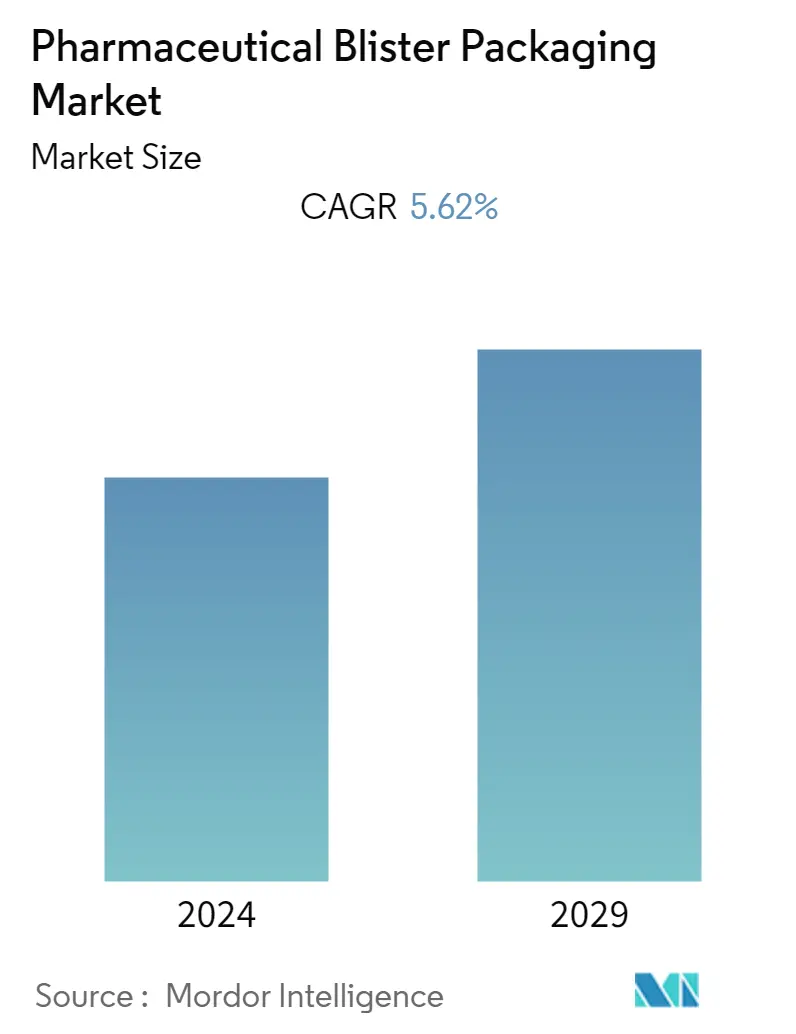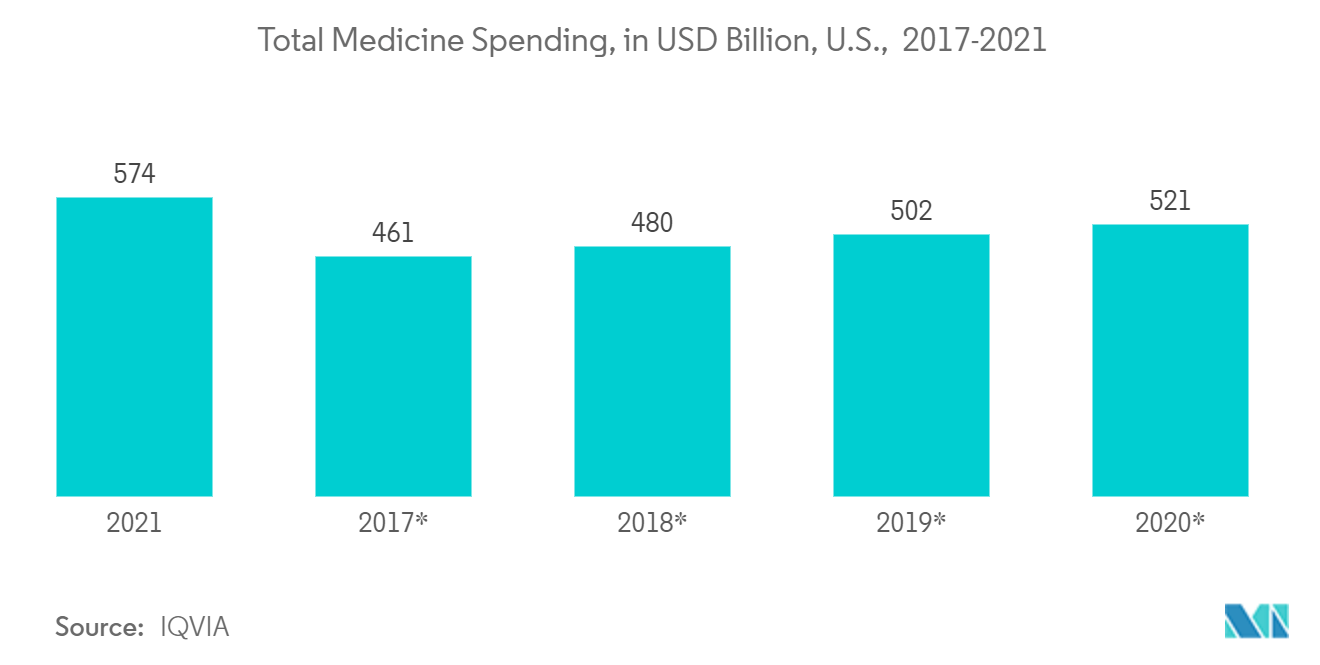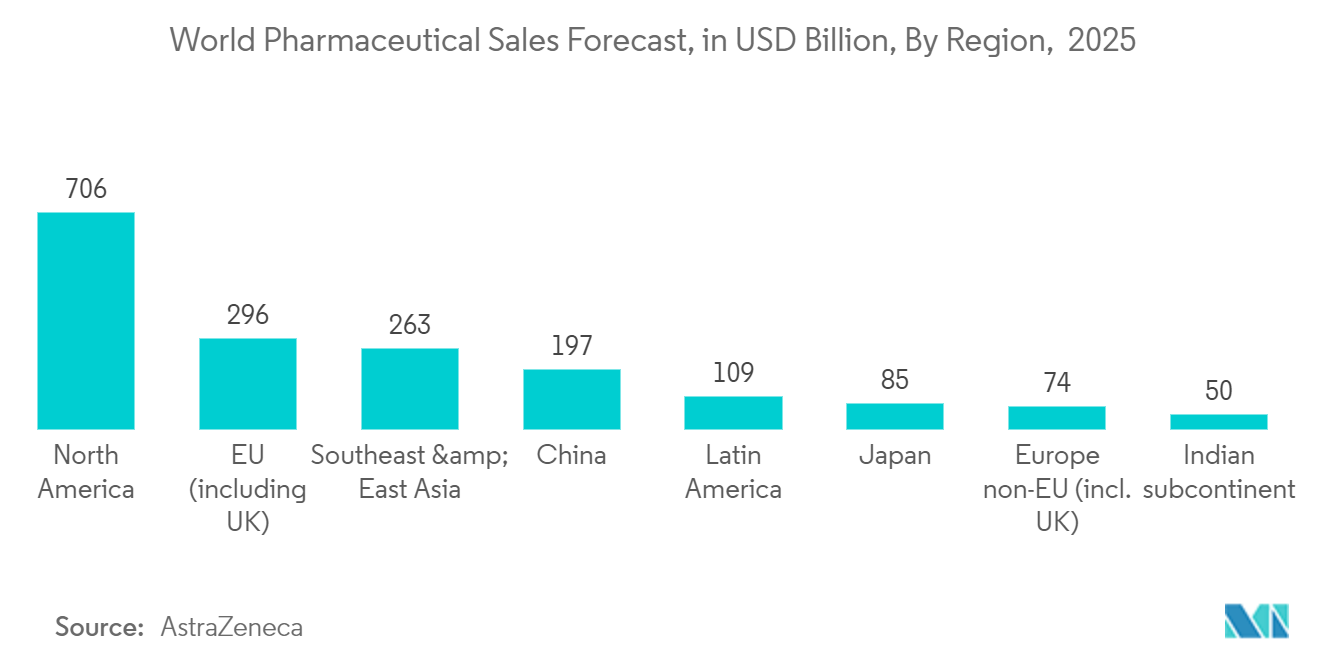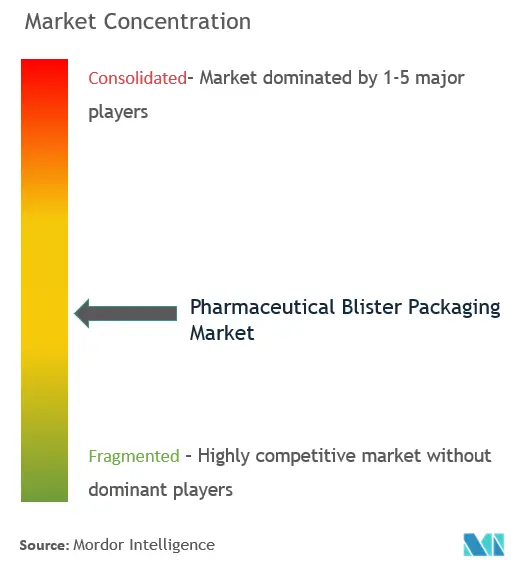Pharmaceutical Blister Packaging Market Size

| Study Period | 2019 - 2029 |
| Base Year For Estimation | 2023 |
| CAGR | 5.62 % |
| Fastest Growing Market | Asia-Pacific |
| Largest Market | North America |
| Market Concentration | Medium |
Major Players
*Disclaimer: Major Players sorted in no particular order |
Pharmaceutical Blister Packaging Market Analysis
The pharmaceutical blister packaging market is estimated to register a CAGR of 5.62 from 2022 to 2027. The market comprises different packaging solutions, technologies, and components according to the applications. The companies focus on recyclable materials through in-house research, development programs, and collaboration with material providers. Such innovations and the demand for decreasing carbon footprints drive the market.
- Packaging plays an important role in the pharmaceutical industry. The tamper- and damage-free delivery of medicinal products from pharmaceutical manufacturing companies to the patients is achieved by specialized packaging options. Blister packaging is one o those options that keep the therapeutic commodities safe, moisture-free, and protected from as many external contaminants as possible.
- Pharmaceutical packaging has witnessed several options, including stoneware storage, glassware storage (preferred to date for some medicines), and plastic containers and bottles. Blister packaging was picked in the 19th century and has evolved with the needs of the pharmaceutical industry to suit the different applications. The blister packaging can comprise thermoformed plastic with the lid formed out of paper, plastic, foil, or a combination of any of these. Another form of blister packaging prevalent has been the one formed solely from foil, leveraging the cold-stretching process. The opaque alternatives in either provided light-sensitive medicines protection from UV rays.
- Blister packaging proves to be a robust form of packaging and transporting the medical essentials. The packaging protects from blows, wet conditions, and heat, providing better shelf life and transportation abilities of the medicines. Such virtues of blister packaging came into light during the pandemic when the surface of the packaging played a vital role in transporting and storing medications internationally. However, the transfer of the virus through the surface underscored the scope of improvement in the outer materials that the packaging manufacturers will focus on in the coming times.
- The COVID-19 pandemic increased the demand for medicinal products deploying blister packaging but faced issues with the movement of raw materials due to international lockdown restrictions. Many blister packaging players supported the situation by altering the manufacturing processes by adapting to the need of the hour. For instance, Pharmaworks, a ProMach product brand specializing in pharmaceutical blister packaging machinery, donated more than 17,000 face shields to help meet the needs of healthcare professionals and first responders.
Pharmaceutical Blister Packaging Market Trends
This section covers the major market trends shaping the Pharmaceutical Blister Packaging Market according to our research experts:
Innovation for New Recyclable Materials Shaping the Market
- As the environmental laws become more stringent, pharmaceutical packaging vendors are looking for better recyclability of materials used for blister packaging. Presently, most blister packaging involves heavy use of materials, like PVC, PVDC, foil, etc. These also include single-use plastics, which cannot be recycled or composted and harm the environment. Hence, companies are developing new recyclable thermoformed plastic solutions and materials for kidding films about supporting the recyclability of the blister packages.
- Several companies are coming up with new packaging recyclable materials for blister packaging. For instance, AmSky Blister System offered by Amcor PLC is a recyclable alternative to existing blister packaging solutions. AmSky features a vinyl and aluminum-free thermoform system and is based on PE for recycling in rigid and flexible recycling streams. Amcor uses UV Flexo Multi GIages, its patented child-resistant/senior-friendly solution, offering a moisture barrier for the security of supply. The clinical trials of the solutions have already begun, making them available in the market by the second half of 2022.
- Governments are boosting the ban on non-biodegradable plastics and other environmentally-hazardous materials, which will affect the film materials and thermoform options used in the pharmaceutical blister packaging. For instance, in June 2022, the public information bureau (PIB) requested the states to ban Single-Use Plastics (SUP) under the "Clean and Green" campaign launched by the Ministry of Housing and Urban Affairs. The ban aims to stop manufacturing products containing SUPs completely by July 2022.
- The increasing spending on medicine fuels the concern for the material used in blister packaging the pharmaceuticals. The widespread demand for medicine makes it critical if more non-recyclable materials are used in the process, making it difficult to recycle later. Government initiatives like European Plastics Pact operate at a mass level, addressing households, hospitality, industries, retailers, etc., to boost the recyclable materials on a wider and more effective scale, banning the use of SUPs. Such measures also validate the shift to recyclable alternatives in the blister packaging sector for the long run.
- With the increasing consumption of medicines protected and transported through blister packaging and government laws promoting the use of recyclable materials, the blister packaging CDMOs and CMOs are looking forward to altering the form-fill-seal and other production line equipment according to the future of the industry. Thus, the use of recyclable materials, including paperboard, PET, aluminum, etc., will rise, affecting the packaging firms and film suppliers.

Increasing Drug Consumption to Drive the Market
- The amount of medicines consumed is increasing globally with each passing year. Since the manufacture of medicines is ever-increasing, catering to the discoveries of diseases and their remedies, the demand for packaging is impacted directly. The need for flexible packaging options like blister packaging is among the most preferred methods, as they profile tamper-free, leak-proof packaging options, which can be implemented for bulk operations to attain fast and reliable packaging.
- The increased supply of Active Pharmaceutical Ingredients (APIs) has also increased the demand for blister packaging. The new developments in the number of API manufacturing and development facilities are boosting the demand for blister packaging components. For instance, in May 2022, Pfeifer announced the operationalization of its only drug development center in Asia, a 61,000 sq. ft. facility located in Chennai, Tamil Nadu, India. The Investment of USD 20 million is dedicated to developing the company's offerings, including APIs and Finished Dosage forms (FDFs). Three of the company's manufacturing plants in India will benefit from the progress made in APIs by such facilities.
- The increase in global spending on medicine impacts blister packaging positively. The developed countries display a better adoption rate for improved healthcare diagnostics and overall standards, including medicine, contributing to the medical spending. The development in drug access in developed and pharmerging countries has played a vital role in increasing drug consumption, driving the demand, and indirectly paving the scope for blister packaging in medicine. The evolution of e-commerce platforms has contributed to strengthening drug access and complying with the stringent regulations for safe logistics.
- Several government initiatives promote bulk drug manufacturing to meet the increasing demand for medicines. For instance, in May 2022, the Department of Pharmaceuticals (DoP) in India separated the items into three categories: formulations, biopharmaceuticals, bulk medications, and in-vitro diagnostic medical devices, among others, formulated a system for respective incentives to promote local manufacturing. On incremental sales, the first and second categories would receive a 10% reward, while the third would receive a 5% bonus. The government quoted that it would provide the scheme to up to 55 drugmakers with a total of Rs 15,000 crore in production-linked incentives over the following six years through FY29.

Pharmaceutical Blister Packaging Industry Overview
The pharmaceutical blister packaging market is moderately competitive, displaying moderate fragmentation. The market comprises major and local players supplying raw materials and packaging services. The portfolio of different brands with the latest blister packaging technologies and film types attracts major pharmaceutical clients and continues with the services accordingly. The latest developments in packaging and film materials are shaping the market.
- May 2022 - Terracycle partnered with Honeywell to conclude the recyclability of Honeywell's Aclar Barrier Film Blisters. The film material used by Honeywell in various pharmaceutical applications, including Aclar Edge bottles, is declared technically recyclable for PVC and PETG-based blisters. The technical recyclability for Aclar film blisters is presently tested at a lab scale and is in the process of real-world declaration.
- April 2022 - Amcor, a global company developing and producing responsible packaging solutions, announced a multi-million-dollar investment to establish new thermoforming capabilities in its Sligo, Ireland, healthcare packaging facility dedicated to medical packaging. The investment will strengthen the company's market position in the growing industry for sterile packaging, offering customers in Europe and North America another site with comprehensive healthcare solutions.
Pharmaceutical Blister Packaging Market Leaders
-
Amkor PLC
-
Constantia Flexibles GmbH
-
WestRock Company
-
Klöckner Pentaplast Group
-
Honeywell International Inc.
*Disclaimer: Major Players sorted in no particular order

Pharmaceutical Blister Packaging Market News
- April 2022 - Amcor announced the customer trials of the world's first recyclable (Recyclability independently verified by cyclos-HTP) Polyethylene-based thermoform blister packaging, AmSky, marking a breakthrough innovation in blister packaging. The new packaging meets the stringent requirements of highly specialized and regulated pharmaceutical packaging. The new design omits PVC (PolyVinyl Chloride) from the packaging by using a Polyethylene (PE) thermoform blister and lidding film. The brand is working with several pharmaceutical companies to bring AmSky to market globally, expecting its availability by the second half of 2022.
- April 2022 - Klöckner Pentaplast (kp), a global player in recycled content products and high-barrier protective packaging, announced a multi-million dollar production expansion in its production facility in Beaver, West Virginia. The investment adds post-consumer recycled content (PCR) PET capacity in North America. The expansion adds an extrusion line and two thermoformers, delivering 15,000 metric tonnes of new rPET/PET capacity, benefitting offerings for consumer health, pharmaceutical, and food packaging markets. The extrusion line will aid the production of important sustainable product lines, including kpNext recyclable pharmaceutical blister films and Smartcycle recyclable label and consumer packaging films. The thermoformers will produce kp Elite mono-material protein trays, which are made using up to 100% recycled PET and are easily recycled, creating a circular economy.
Pharmaceutical Blister Packaging Market Report - Table of Contents
1. INTRODUCTION
- 1.1 Study Assumption And Market Defination
- 1.2 Scope of the study
2. RESEARCH METHODOLOGY
3. EXECUTIVE SUMMARY
4. MARKET INSIGHTS
- 4.1 Market Overview
-
4.2 Industry Attractiveness - Porter's Five Forces Analysis
- 4.2.1 Bargaining Power Of Suppliers
- 4.2.2 Bargaining Power Of Buyers
- 4.2.3 Threat Of New Entrants
- 4.2.4 Threat Of Substitutes
- 4.2.5 Intensity Of Competitive Rivalry
- 4.3 Value Chain Analysis
- 4.4 Assessment of the Impact of Covid-19 on the Market
5. MARKET DYNAMICS
-
5.1 Market Drivers
- 5.1.1 Increase in the Application of Thermoforming Technology
- 5.1.2 Rise in Use for Tablets and Capsules
-
5.2 Market Challenges/Restraints
- 5.2.1 Shift from Conventional Materials to New Recyclable Materials
6. MARKET SEGMENTATION
-
6.1 Segmentation - By Type
- 6.1.1 Compartment Blister Packs
- 6.1.2 Slide Blister Packs
- 6.1.3 Other Blister Packs
-
6.2 Segmentation - By Component
- 6.2.1 Films
- 6.2.2 Lidding Materials
- 6.2.3 Secondary Containers
- 6.2.4 Packaging Accessories
-
6.3 Segmentation - By Geography
- 6.3.1 North America
- 6.3.2 Europe
- 6.3.3 Asia Pacific
- 6.3.4 Africa
- 6.3.5 Rest of the World
7. COMPETITIVE LANDSCAPE
-
7.1 Company Profiles
- 7.1.1 Amcor Limited
- 7.1.2 Constantia Flexibles
- 7.1.3 WestRock Company
- 7.1.4 Klockner Pentaplast Group
- 7.1.5 Sonoco Products Company
- 7.1.6 Honeywell International Inc.
- 7.1.7 RENOLIT SE
- 7.1.8 Winpak Ltd
- 7.1.9 Uflex Ltd
- 7.1.10 ACG Pharmapack Pvt Ltd
- 7.1.11 Tekni-Plex, Inc
- 7.1.12 Carcano Antonio
- 7.1.13 Caprihans India Limited
- *List Not Exhaustive
8. INVESTMENT ANALYSIS
9. MARKET FUTURE OUTLOOK
** Subject To AvailablityPharmaceutical Blister Packaging Industry Segmentation
Blister packaging refers to the cavity formed in plastic through thermoplastic, according to the medical equipment, tablet, or any other commodity as per its size, covered by a lid to encapsulate it safely. This way of packaging secures the medical item for safe usage, comprising different packaging components. The pharmaceutical blister packaging market is segmented by type (compartment blister packs and slide blister packs), component (films, lidding materials, secondary containers, and packaging accessories), and geography.
| Segmentation - By Type | Compartment Blister Packs |
| Slide Blister Packs | |
| Other Blister Packs | |
| Segmentation - By Component | Films |
| Lidding Materials | |
| Secondary Containers | |
| Packaging Accessories | |
| Segmentation - By Geography | North America |
| Europe | |
| Asia Pacific | |
| Africa | |
| Rest of the World |
Pharmaceutical Blister Packaging Market Research FAQs
What is the current Pharmaceutical Blister Packaging Market size?
The Pharmaceutical Blister Packaging Market is projected to register a CAGR of 5.62% during the forecast period (2024-2029)
Who are the key players in Pharmaceutical Blister Packaging Market?
Amkor PLC, Constantia Flexibles GmbH, WestRock Company, Klöckner Pentaplast Group and Honeywell International Inc. are the major companies operating in the Pharmaceutical Blister Packaging Market.
Which is the fastest growing region in Pharmaceutical Blister Packaging Market?
Asia-Pacific is estimated to grow at the highest CAGR over the forecast period (2024-2029).
Which region has the biggest share in Pharmaceutical Blister Packaging Market?
In 2024, the North America accounts for the largest market share in Pharmaceutical Blister Packaging Market.
What years does this Pharmaceutical Blister Packaging Market cover?
The report covers the Pharmaceutical Blister Packaging Market historical market size for years: 2019, 2020, 2021, 2022 and 2023. The report also forecasts the Pharmaceutical Blister Packaging Market size for years: 2024, 2025, 2026, 2027, 2028 and 2029.
Pharmaceutical Blister Packaging Industry Report
Statistics for the 2024 Pharmaceutical Blister Packaging market share, size and revenue growth rate, created by Mordor Intelligence™ Industry Reports. Pharmaceutical Blister Packaging analysis includes a market forecast outlook to 2029 and historical overview. Get a sample of this industry analysis as a free report PDF download.



